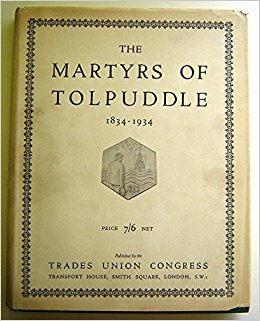Inspiring Older Readers
 posted on 28 Jan 2018
posted on 28 Jan 2018
The Martyrs of Tolpuddle 1834-1934 by The Trades Union Congress
Here is another example of what you can find if you’re prepared to scrabble around on the lower shelves of junk shops. Hidden away in a rather tatty, plain brown cardboard box was this little gem. Produced by the TUC in 1934 this is a pretty extravagantly produced anniversary publication that I suspect was never on public sale – it looks very much like it was a presentation edition that probably went to TUC affiliates and trade union General Secretaries.

Truthfully, it’s a slightly odd confection but fascinating for all that. It bears all the hallmarks of a book put together by a committee who were determined to crowbar everything they could into the book. We start off with a bewildering foreword by George Bernard Shaw:
I am afraid I cannot say anything in praise of the Dorchester martyrs….There is this, however, to be said for the Dorchester men. They got transported at the expense of their landlords and employers. As they could hardly, if they were reasonable men, have desired to live in Dorset as slaves – for that is what it came to – they were lucky to be pushed out of it.

I can only imagine the TUC were at a bit of a loss with this – an endorsement from one of the big names of literature but one that is, to be kind, so eccentric it must have left some of the committee scratching their heads.
This is followed by a word from the Chair of the TUC and a more substantial introduction from the Fabian luminaries Sidney and Beatrice Webb. But the substantive text telling the history of the Tolpuddle Martyrs is the work of Walter Citrine, one of the TUC General Secretaries who went on to establish a reputation as a consummate constitutional bureaucrat.

The text mixes cartoons by the likes of David Low and Will Dyson with sketches and maps by Frank Horrabin. There are some coloured plates by W.G. Easton that are oddly reminiscent of the sort of artwork you might find in a period children’s history book – a design touch that gives the publication a slightly odd feel because the text is obviously not aimed at a younger audience. Another example I suspect of design decisions made by committee.
One of the more interesting components you find here, and which I haven’t seen before, is the direct transcripts of the legal hearings against the men. These do more than any commentary could to illustrate the extraordinary partiality of the legal process – these men clearly never had a chance of being found anything other than guilty.


The second half of the book includes contributions in the form of short essays by G.D.H. Cole and H.V. Morton and a view from a parliamentary perspective by Arthur Henderson M.P. At the end there’s a very useful who’s who and glossary for those who are less familiar with the story.
This really is a curiosity: there are a few ex-library copies online for under £20 but the few in good condition don’t have dust jackets or the original box and you’ll pay over £30 for these.
Terry Potter
January 2018
